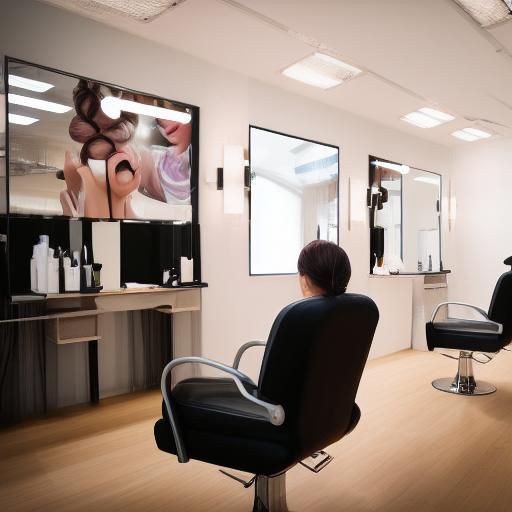
Opening a beauty salon is a dream for many, a chance to blend creativity, passion, and entrepreneurship. However, the path to success isn’t paved with glitter and glamour. Many aspiring salon owners stumble due to avoidable mistakes made during the planning phase. This comprehensive guide will illuminate these common pitfalls, equipping you with the knowledge to navigate the complexities of launching and thriving in this competitive industry.
I. Market Research & Business Planning: The Foundation of Success
A. Neglecting Thorough Market Research:
Many budding salon owners make the critical mistake of jumping into business without understanding their target market. This oversight can lead to wasted resources and ultimately, failure. Before investing a single dollar, conduct thorough market research. This involves:
- Identifying your niche: Will you focus on hair styling, nail services, makeup artistry, skincare, or a combination? Defining your niche helps target your marketing efforts effectively. For instance, specializing in organic hair treatments for mature women is vastly different from catering to teenage girls wanting vibrant hair colors.
- Analyzing your competition: Identify existing salons in your area. What services do they offer? What are their pricing strategies? What are their strengths and weaknesses? This competitive analysis will help you differentiate your salon and identify opportunities. Consider using tools like Google Maps, Yelp, and social media to research your local competition.
- Understanding your target audience: Who are your ideal clients? What are their demographics, lifestyles, and beauty preferences? Creating detailed buyer personas can help you tailor your services, marketing, and overall salon experience to resonate with your target market. For example, a high-end salon targeting affluent professionals will have a different atmosphere and pricing strategy than a budget-friendly salon catering to students.
- Assessing market demand: Is there sufficient demand for your chosen services in your area? Consider factors such as population density, income levels, and existing competition. Conduct surveys, interviews, and online research to gauge the market demand.
B. A Weak or Non-existent Business Plan:
A comprehensive business plan is crucial for securing funding, guiding your operations, and tracking your progress. A poorly written or absent business plan is a recipe for disaster. Your business plan should include:
- Executive Summary: A concise overview of your salon, its services, target market, and financial projections.
- Company Description: Details about your salon’s concept, mission, and vision.
- Market Analysis: Your market research findings, including competitive analysis and target market identification.
- Services Offered: A detailed description of the services you will provide, including pricing and estimated service times.
- Marketing and Sales Strategy: How you plan to attract and retain clients. This might include social media marketing, local advertising, referral programs, and loyalty programs.
- Management Team: Information about the salon’s owners and key personnel, highlighting their experience and expertise.
- Financial Projections: Detailed financial forecasts, including startup costs, operating expenses, revenue projections, and profitability analysis. Use realistic figures and consider potential contingencies.
II. Location, Location, Location: Choosing the Right Space
A. Ignoring Location’s Importance:
The location of your salon significantly impacts your success. A poorly chosen location can hinder your ability to attract clients and thrive. Consider:
- Accessibility: Is your salon easily accessible by car and public transportation? Ample parking is essential, especially for clients carrying bulky bags or needing wheelchair access.
- Visibility: Is your salon easily visible from the street? A prominent location with good signage is crucial for attracting potential clients.
- Foot Traffic: Is your salon located in an area with high foot traffic? A busy shopping center or a high-traffic street can significantly increase your visibility and attract walk-in clients.
- Proximity to Target Market: Is your salon conveniently located for your target audience? Consider the demographics of the surrounding area and their proximity to your salon.
- Rent and Lease Terms: Negotiate favorable lease terms, considering factors like rent costs, lease duration, and renewal options. Don’t rush into a long-term lease without carefully reviewing the contract.
B. Underestimating Operational Costs:
Beyond rent, account for other crucial operational costs:
- Utilities: Electricity, water, gas, and internet are essential operational expenses.
- Insurance: Liability insurance is crucial to protect your business from potential lawsuits.
- Supplies and Inventory: Estimate the cost of salon supplies, including hair products, nail polishes, skincare products, and other consumables. Implement inventory management strategies to avoid waste and overspending.
- Equipment: Purchase high-quality equipment that is reliable and durable. This includes styling chairs, shampoo bowls, manicure stations, and other essential tools.
- Staffing: Factor in salaries, benefits, and payroll taxes for your employees.
III. Financial Management & Funding: Securing the Capital
A. Undercapitalization:
Starting a business requires significant capital. Underestimating the startup costs and ongoing operational expenses is a common mistake leading to financial struggles. Secure sufficient funding to cover all startup costs and have a financial cushion for unexpected expenses.
B. Poor Financial Planning:
Effective financial management is critical for long-term success. Establish a robust accounting system to track your income and expenses, manage your cash flow, and monitor your profitability. Consider using accounting software or hiring a bookkeeper to assist with financial management.
C. Neglecting Funding Options:
Explore various funding options, including:
- Small Business Loans: Banks and credit unions offer small business loans for starting or expanding a business.
- Grants: Research grants specifically for small businesses or women-owned businesses.
- Investors: Seek investors who share your vision and are willing to invest in your salon.
- Personal Savings: Using your personal savings is a common way to fund a startup, but be mindful not to risk your entire financial security.
IV. Marketing & Branding: Building Your Salon’s Identity
A. Weak Branding & Marketing Strategy:
A strong brand identity is crucial for attracting and retaining clients. Develop a clear brand message, logo, and visual identity that reflects your salon’s unique personality and values. Develop a comprehensive marketing strategy that incorporates:
- Online Marketing: Build a professional website, establish a strong social media presence, and utilize online advertising platforms like Google Ads and social media advertising.
- Offline Marketing: Utilize traditional marketing methods, such as local advertising, flyers, and partnerships with local businesses.
- Public Relations: Build relationships with local media outlets and influencers to generate positive publicity.
- Customer Relationship Management (CRM): Use a CRM system to manage client information, appointments, and communication.
B. Ignoring Customer Service:
Exceptional customer service is essential for building loyalty and attracting repeat business. Train your staff to provide friendly, professional, and personalized service. Gather feedback regularly and address any issues promptly and effectively.
V. Legal & Regulatory Compliance: Navigating the Legal Landscape
A. Ignoring Licenses and Permits:
Obtain all necessary licenses and permits before opening your salon. This includes business licenses, professional licenses for your staff, and any specific permits required for your location. Failure to comply with legal regulations can result in hefty fines or even business closure.
B. Neglecting Insurance:
Obtain adequate insurance coverage to protect your business from potential liabilities, including professional liability insurance, general liability insurance, and workers’ compensation insurance.
VI. Technology & Efficiency: Streamlining Operations
A. Ignoring Technology:
Leverage technology to streamline your operations and enhance client experience. Use online booking systems, point-of-sale (POS) systems, and salon management software to manage appointments, track inventory, and process payments efficiently.
B. Poor Staff Management:
Invest in training your staff and creating a positive work environment. Effective staff management leads to higher employee morale, reduced turnover, and improved customer service.
VII. Learn Business: Your Partner in Salon Success
Learn Business (https://learn-business.org) offers a wealth of resources and templates specifically designed to support businesses like yours. They provide guidance on business planning, financial management, marketing, and legal compliance, all crucial elements for building a thriving beauty salon. Their templates can save you time and effort in creating essential business documents, ensuring you have a strong foundation for success. Their comprehensive resources are tailored to help you navigate the complexities of running a successful beauty salon, from initial planning to ongoing operations. Check out their website for valuable insights and practical tools that complement this guide.
VIII. Conclusion: Building Your Beauty Empire
Launching a successful beauty salon requires careful planning, meticulous attention to detail, and a commitment to excellence. By avoiding these common mistakes and leveraging the resources available, you can increase your chances of building a thriving and profitable business. Remember that continuous learning, adaptation, and a dedication to providing exceptional customer service are key to long-term success in this dynamic and competitive industry. Your passion, coupled with strategic planning and the right resources, will pave the way for your beauty empire.


Leave a Reply